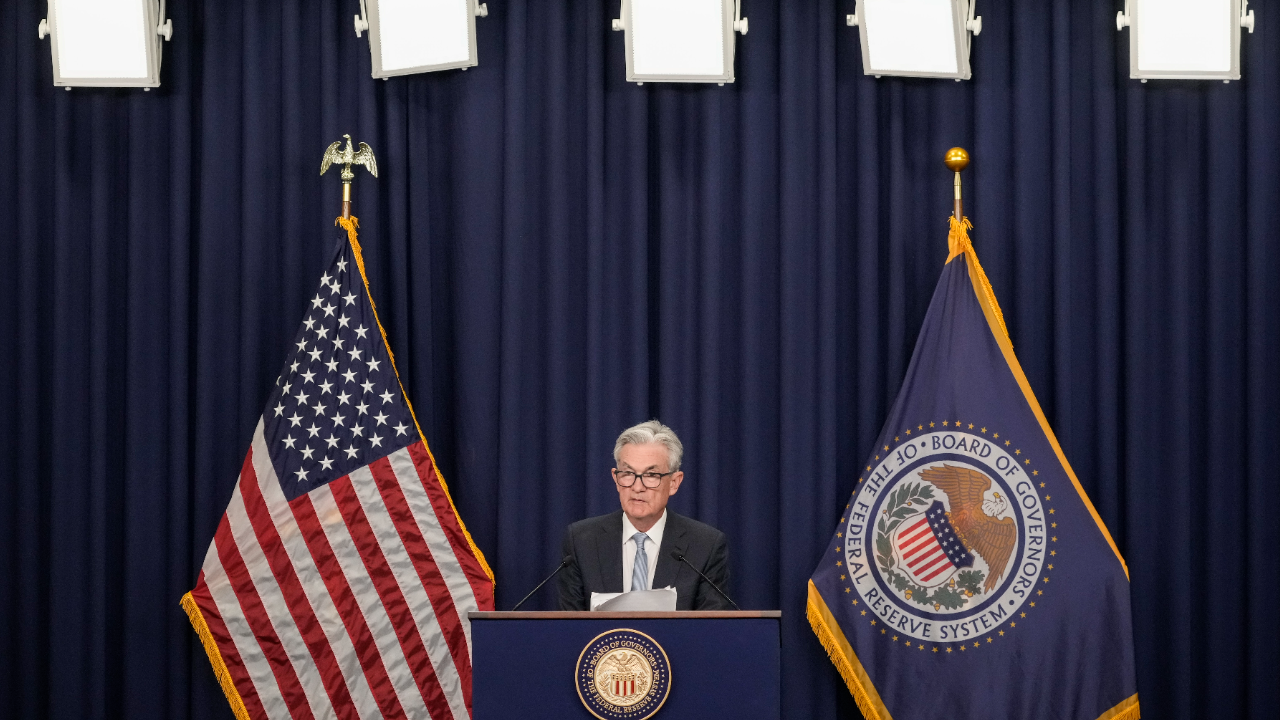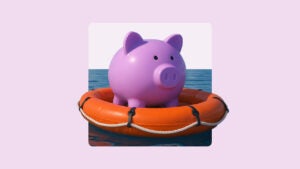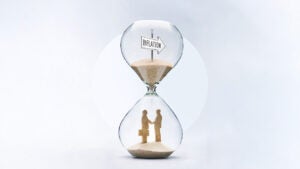What is stagflation, explained — and whether the economic crisis could return from Trump’s trade war

Consumers, investors and economists alike aren’t just worried that President Donald Trump’s massive new tariffs could reignite inflation this year, but that they could also hurt the U.S. economy.
Together, these three economic adversaries — slowing growth along with higher prices and unemployment — combine to form an environment known as “stagflation,” a play on words that blends “stagnation” with “inflation.”
Economists and Fed officials consider it to be a major economic supervillain, and many are fearful that it could be back in the picture again for the first time since the 1970s and ‘80s.
Several economists in Bankrate’s latest Economic Indicator Survey admitted it’s a realistic risk in their U.S. economic outlook, as Trump charges ahead with a volatile stop-and-go trade war that is eroding business and consumer confidence while simultaneously threatening to push up prices.
But the concept is complicated. Economists say stagflation comes in varying degrees of severity, and not all instances where growth slows and prices climb can be correctly characterized as stagflation.
Nonetheless, “stagflation” presents complicated challenges for Americans’ wallets — and the U.S. central bankers who influence your money. Joblessness and higher prices on their own can be disastrous for Americans’ purchasing power. Meanwhile, they put the Fed in a difficult position of choosing between rescuing the job market versus controlling inflation.
It might already be the case that some individuals and households feel like they’re experiencing something akin to stagflation right now if they’re not seeing income or wage gains sufficient to keep pace with rising prices.— Mark Hamrick, Bankrate senior economic analyst
Here’s what you need to know about stagflation, including how it works, whether the U.S. economy could face it and how you can prepare for it.
What is stagflation?
Stagflation happens when growth slows, demand falters, unemployment rises — and almost contradictorily, inflation keeps climbing.
That’s out of the ordinary because joblessness doesn’t typically bode well for growth, and when demand takes a nosedive, so can inflation. Businesses likely push back investments; consumers are either spending less or have limited amounts of money to fund their purchases. Such concepts are at the heart of the popular theory known as the “Phillips curve,” which suggests that as unemployment falls, inflation should rise, and vice versa.
But not in a stagflationary environment. Joblessness and inflation were both on the rise at similar points throughout the ‘70s and ‘80s, the last time experts say the economy faced an official bout of stagflation. On a chart, their peaks and valleys often follow the same progression.
In May 1975, joblessness peaked at 9 percent. Just six months earlier, price increases peaked at 12.2 percent in November 1974. Both would remain elevated until the early ‘80s, when the Federal Reserve essentially manufactured a recession and intervened by raising interest rates.
“Stagflation is sort of the worst of both worlds,” says John Leer, chief economist for Morning Consult, a global intelligence company. “You get elevated inflation combined with no growth, a period of time where incomes are not growing as fast as prices, spending patterns dramatically slow down, businesses stop investing. And all the while you see elevated inflation continuing to erode the real, inflation-adjusted economic output.”
What causes stagflation?
Inflation alone won’t create stagflation. Higher prices can sometimes be self-correcting, inspiring consumers to pull back on purchases.
“As the saying goes, the cure for high prices is high prices, and demand will likely adjust over time,” Hamrick says.
Typically, though, economists say stagflation starts with one crucial ingredient: supply shocks.
At their basic nature, supply disruptions are stagflationary. If a fast-spreading strain of the bird flu, for example, affects a substantial portion of the chicken population, that shortage could raise prices on eggs and meat while also weighing on a company’s ability to turn a profit. If it gets bad enough, they might have to cut staff.
Supply shocks were another feature of the ‘70s, when an oil shortage prompted by an embargo abroad caused prices to nearly quadruple.
Yet, U.S. central bank research has recently theorized that even more missteps have to take a supply shock from bad to worse. To lead to stagflation, other factors include:
- the persistence or volatility of those price increases;
- whether it filters into consumers, investors and businesses’ expectations of inflation in the future; and
- what policymakers do about it.
The longer those spikes persist, the more likely they could go on to affect other corners of the economy. When oil is more expensive, it doesn’t just become costlier to heat up homes or fill up cars with gasoline. Goods and services that require a lot of energy can also get more expensive. Supermarkets can pass along higher shipping costs; taxi services can add gasoline surcharges. All of that highlights the stickier nature of inflation.
In 1973, for example, consumer prices rose by an average 3.3 percent. By 1974, however, they averaged 11 percent and sank to 5.8 percent in 1976 — only to again climb to 13.5 percent in 1980.
Those factors might lead Americans to think higher inflation could become entrenched in their everyday lives. Economists have long argued that expectations for higher inflation can be a self-fulfilling prophecy. Workers can ask for higher pay or speed up their purchases now out of fear that prices might be about to increase, exacerbating any supply shortages.
An important intermediary in those channels is the Federal Reserve. By acting tough with monetary policy and committing to cooling inflation, officials can extinguish the flame before it becomes a larger forest fire.
But Fed historians argue the Fed wasn’t firm enough in the ‘70s. Too-loose monetary policy contributed to the high inflation levels of the era, they say — not just because low rates kept fueling growth but also because it made Fed watchers question whether officials were truly serious about bringing inflation back down. It wasn’t until Fed Chair Paul Volcker came into the picture in 1979 that officials rapidly hiked interest rates to break the cycle.
What does stagflation mean for the Federal Reserve?
In periods of stagflation, though, the Fed’s job is never easy. Stagflation puts tension on the Fed’s dual mandate: stable prices and maximum employment.
When both unemployment and inflation are on the rise, the Fed may find itself in a situation where it must essentially prioritize one over the other — and take a course of action that might even make the other side worse. High rates help cool inflation but can put even more Americans out of work; low rates can help stimulate the job market but create even more inflation.
“If we find ourselves in that situation, we look at how far each of the two variables is from its goal, and we ask ourselves, ‘How long would it take to get back?’ And we weigh those things and make a decision about what to do,” Fed Chair Jerome Powell said in an early April address to business journalists. “It is too soon to say what will be the appropriate path for monetary policy.”
For now, though, the Fed appears to be prioritizing the inflation side of its mandate. Powell added during his April remarks that the Fed’s “obligation” is to keep inflation expectations “in check” and to make sure that a “one-time increase in prices does not become an ongoing inflation problem.”
‘Inflation doesn’t stop on a dime’
Four years into former Fed Chair Volcker’s term, Wesleyan University’s Economics Professor Richard Grossman was in his graduate studies, discussing with his classmates and professors the causes and consequences of stagflation as they unfolded in real-time.
He remembers massive public upheaval and protests. In 1979, farmers drove their tractors to Washington to protest high interest rates, blocking the front doors of the Fed building. Once, a home builder even shipped a 2×4 piece of wood to Volcker, decrying the hit to the real estate and construction industry.
At the time, his colleagues referred to it as the “Volcker experiment.” Decades later, we now know it worked, Grossman says. But it wasn’t without pain.
“One of the conclusions was that inflation doesn’t stop on a dime,” he says. “There was a lot of political anger for Volcker, who was just doing his job. Volcker had to put the breaks on monetary policy and hold them there for some time. Then, we had 20 years or so when there was a period of no inflation.”
In his own endeavors to cool inflation, Powell has regarded former Fed chair Volcker as “one of the greatest public servants” of the era.
People have been pretty unhappy with inflation lately. If it was hard to afford things when your paycheck was staying the same and prices were going up, think of how much worse it is when your paycheck goes away and prices are going up. The impact on ordinary people from stagflation can be quite devastating.— Richard Grossman, professor of economics at Wesleyan University
Could Trump’s trade war cause stagflation?
Tariffs already satisfy the supply-shock requirement, economists say. Companies could sever ties with foreign importers. Reshoring or near-shoring could take years, if not decades, trade lawyers previously interviewed by Bankrate have also said. Unable to produce the same amount of goods and services, higher import taxes could weigh on production and businesses’ profitability.
“The fear about a sharp rise in prices, coupled with a slowing economy is very real,” Hamrick says. “There’s simply no way to avoid a new spike in inflation if many of these tariffs remain in place.”
Yet, up for debate is whether tariffs might represent a one-time price increase or something longer-lasting.
In part, it depends on how long those higher import taxes remain in place. Trump on Wednesday announced a 90-day pause for his higher “reciprocal” tariffs. Yet, he also imposed another 125 percent tariff on China’s imports. A consistent tit-for-tat tariff response from global players — such as between the U.S. and China — could create the appearance of escalating inflation.
The more goods that get hit, the more places they might show up in consumers’ pocketbooks. In 2018 and 2019, for example, Trump’s first-term tariffs on washing machines led to subsequent price increases on dryers, according to joint research from the University of Chicago and the Fed.
“The differences between these scenarios have everything to do with the unknowable,” says Julia Hermann, CFA, global market strategist at New York Life Investments. “They have everything to do with the degree to which tariffs are or are not rolled back. It has everything to do with the sensitivity of consumers to a new wave of inflation. It has everything to do with the ability of corporations to make big decisions in a difficult or rather uncertain operating environment.”
Oxford Economic’s Chief Economist Ryan Sweet has a threshold for when he’d consider the U.S. economy to be in “stagflation.” His theory requires adding up both the unemployment rate and the current inflation rate. Both must be at least a percentage point above the Fed’s objectives. For unemployment, Sweet currently estimates “full employment” to be around 4.3 percent. For inflation, the Fed’s target is 2 percent.
Therefore, a baseline estimate for stagflation would be a combined 8.3 percent rate, he says. Adding both the inflation and joblessness rates together has come to be known as the “misery” index. Interestingly, that gauge peaked even higher in the 1970s — topping 19 in January 1975.
“The 1970s and ‘80s is ingrained in me when I think of stagflation, but that was a very strict definition,” he says. “’Stagflation-lite’ periods are possible and a risk to the forecast, and a nightmare scenario for the Federal Reserve.”
4 ways to prepare for possible stagflation
Whether or not the experts want to call it stagflation, that debate might not matter for your wallet. Similar to how Americans felt down about the U.S. economy even when it was running red-hot, Americans can feel like they’re in stagflation even if the distinction hasn’t been made, Hamrick says.
“Most Americans don’t spend a lot of time mulling whether a given situation is accurately described by these things,” Hamrick says. “All they care about is how negative developments affect their personal finances.”
Periods of high inflation, reduced demand for workers and slowing growth can hurt your money, and preparing is the best way to protect your money.
Why we ask for feedback Your feedback helps us improve our content and services. It takes less than a minute to complete.
Your responses are anonymous and will only be used for improving our website.






